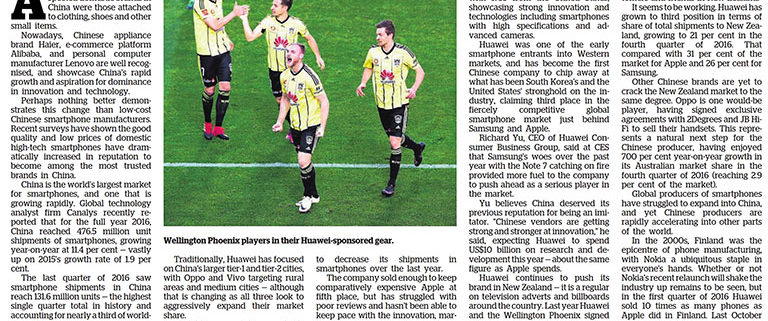China Business: Chinese brands make their mark (NZ Herald)
Tim McCready
A decade ago, the most respected domestic brands in China were those attached to clothing, shoes and other small items.
Nowadays, Chinese appliance brand Haier, e-commerce platform Alibaba, and personal computer manufacturer Lenovo are well recognised, and showcase China’s rapid growth and aspiration for dominance in innovation and technology.
Perhaps nothing better demonstrates this change than low-cost Chinese smartphone manufacturers. Recent surveys have shown the good quality and low prices of domestic high-tech smartphones have dramatically increased in reputation to become among the most trusted brands in China.
China is the world’s largest market for smartphones, and one that is growing rapidly. Global technology analyst firm Canalys recently reported that for the full year 2016, China reached 476.5 million unit shipments of smartphones, growing year-on-year at 11.4 per cent — vastly up on 2015’s growth rate of 1.9 per cent.
The last quarter of 2016 saw smartphone shipments in China reach 131.6 million units — the highest single quarter total in history and accounting for nearly a third of worldwide shipments.
Leading the charge in the Chinese smartphone market are Huawei, Oppo and Vivo. Their rankings jump around depending on how the data you use is captured (shipments to resellers, reported sales, phone activations), but all have experienced strong growth in sales numbers over the past year.
Traditionally, Huawei has focused on China’s larger tier-1 and tier-2 cities, with Oppo and Vivo targeting rural areas and medium cities — although that is changing as all three look to aggressively expand their market share.
The Chinese smartphone market is not without its challenges. Xiaomi was once considered by many to be the “Apple of China”. Xiaomi’s CEO, Lei Jun, has been on a mission to “change the world’s view of Chinese products”.
Yet Xiaomi has slipped to fourth place in the Chinese smartphone war, and is the only one of the top brands to decrease its shipments in smartphones over the last year.
The company sold enough to keep comparatively expensive Apple at fifth place, but has struggled with poor reviews and hasn’t been able to keep pace with the innovation, marketing, and investment into distribution channels of its domestic competitors.
Globally, Chinese brands are making big strides into international markets. Earlier this year at the Consumer Electronics Show (CES), an annual tradeshow for consumer electronics held in Las Vegas, many analysts reported that China’s presence marked a big change. Chinese companies were present in record numbers — 1575 exhibitors compared with 1755 from the United States, showcasing strong innovation and technologies including smartphones with high specifications and advanced cameras.
Huawei was one of the early smartphone entrants into Western markets, and has become the first Chinese company to chip away at what has been South Korea’s and the United States’ stronghold on the industry, claiming third place in the fiercely competitive global smartphone market just behind Samsung and Apple.
Richard Yu, CEO of Huawei Consumer Business Group, said at CES that Samsung’s woes over the past year with the Note 7 catching on fire provided more fuel to the company to push ahead as a serious player in the market.
Yu believes China deserved its previous reputation for being an imitator.
“Chinese vendors are getting strong and stronger at innovation,” he said, expecting Huawei to spend US$10 billion on research and development this year — about the same figure as Apple spends.
Huawei continues to push its brand in New Zealand — it is a regular on television adverts and billboards around the country. Last year Huawei and the Wellington Phoenix signed the largest sponsorship deal in New Zealand football history, extending their initial three-year partnership for at least another three seasons.
At the time, Huawei global rotating CEO Guo Ping said connecting with football fans through the Phoenix had been a huge part of growing the brand in New Zealand.
“This partnership has been outstanding for Huawei, building our profile in Australasia, and providing amazing experiences for our customers and friends in New Zealand.”
It seems to be working. Huawei has grown to third position in terms of share of total shipments to New Zealand, growing to 21 per cent in the fourth quarter of 2016. That compared with 31 per cent of the market for Apple and 26 per cent for Samsung.
Other Chinese brands are yet to crack the New Zealand market to the same degree. Oppo is one would-be player, having signed exclusive agreements with 2Degrees and JB Hi-Fi to sell their handsets. This represents a natural next step for the Chinese producer, having enjoyed 700 per cent year-on-year growth in its Australian market share in the fourth quarter of 2016 (reaching 2.9 per cent of the market).
Global producers of smartphones have struggled to expand into China, and yet Chinese producers are rapidly accelerating into other parts of the world.
In the 2000s, Finland was the epicentre of phone manufacturing, with Nokia a ubiquitous staple in everyone’s hands. Whether or not Nokia’s recent relaunch will shake the industry up remains to be seen, but in the first quarter of 2016 Huawei sold 10 times as many phones as Apple did in Finland. Last October Huawei passed Samsung to claim the top spot of the smartphone market there.
High specifications and low prices might just be a winning formula for Huawei and others to take on Apple and Samsung — the top players in the industry since 2011 — and expand their dominance in China and Finland to the world.




Leave a Reply
Want to join the discussion?Feel free to contribute!